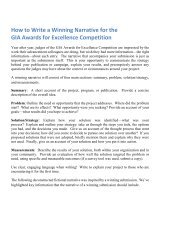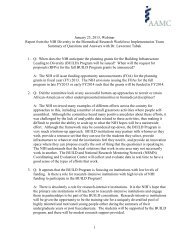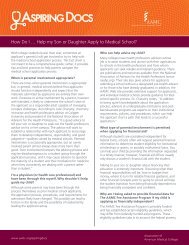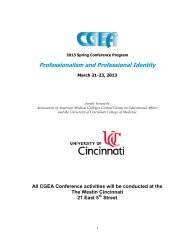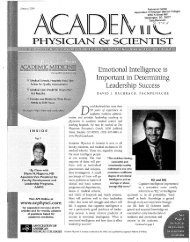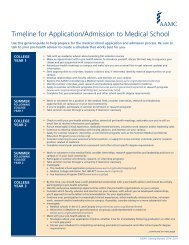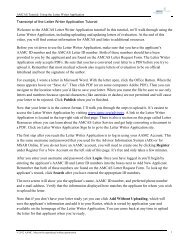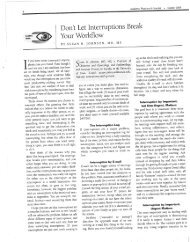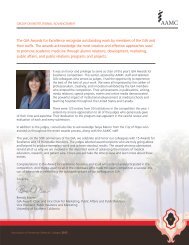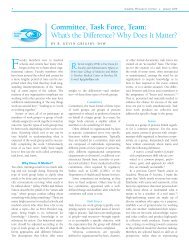2013 Poster Session Summaries - AAMC
2013 Poster Session Summaries - AAMC
2013 Poster Session Summaries - AAMC
You also want an ePaper? Increase the reach of your titles
YUMPU automatically turns print PDFs into web optimized ePapers that Google loves.
Conclusion:<br />
As social media is becoming an increasingly common avenue of communication and personal expression,<br />
medical educators must recognize that it does and will continue to reflect on an applicant’s professionalism.<br />
This does not, however, imply that medical students should avoid social media altogether—as shown in the<br />
above data, a student’s social media presence has the potential to reflect positively on their professionalism.<br />
Instead, instruction should be given to medical students on how to shape a professional social media<br />
presence, much in the way instruction would be given on how to prepare a professional CV. Currently, there<br />
are no established guidelines regarding social media presence and medical education. As part of educating<br />
medical students on digital professionalism, a unified consensus should be reached regarding what is and is<br />
not appropriate for medical trainees to communicate through social media.<br />
WAKE FOREST SCHOOL OF MEDICINE [<strong>Poster</strong> # 68]<br />
Program/Project Title: Emergency Medicine in the Third Year Curriculum<br />
Presenter(s): Daniel Oldroyd & Charlie Pitts<br />
Email: doldroyd@wakehealth.edu<br />
An Emergency Medicine curriculum in the third year of medical school serves to benefit the student, staff,<br />
faculty, and institution as a whole. In the Emergency Department, students are given the unique opportunity<br />
to approach patients with general complaints and broad differential diagnoses in an acute care setting.<br />
While inpatient medicine grants daily opportunities to manage patients’ problems, the primary care setting of<br />
the emergency department allows students to triage patients, make new diagnoses, and to manage these<br />
new diagnoses. In the ED, students gain unique exposure to procedures, treatment algorithms,<br />
interdisciplinary teams, cost conscious decision making, and some health policies. Students' presence<br />
encourages an education-oriented atmosphere, and provides faculty and staff additional leadership and<br />
teaching opportunities. Currently, about 33% of US allopathic medical schools have a required third year<br />
rotation in Emergency Medicine. Given the advantages mentioned above, we believe this rotation to be<br />
greatly beneficial to our students and institution. For our poster, we plan to outline the recommendations as<br />
given in current literature on the subject, and compare those recommendations to the current curriculum that<br />
is in place at the Wake Forest School of Medicine. By doing so, we hope to share the potential benefits of<br />
implementing such a curriculum at other institutions, as well as some logistical information in regard to the<br />
implementation of our EM curriculum.<br />
WAYNE STATE UNIVERSITY SCHOOL OF MEDICINE [<strong>Poster</strong> # 69]<br />
Program/Project Title: A Promising Pipeline to Medical Education: The Detroit Premedical Scholars<br />
Program<br />
Presenter(s): Osamuedemen Iyoha, Robert Guglielmo & Tahsin Khundkar<br />
Email: oiyoha@med.wayne.edu<br />
Increasing the number of underrepresented minorities in medical education is of critical importance, as this<br />
directly and positively impacts the quality of patient care, health outcomes, and health disparities. Through its<br />
many pipeline programs, the Office of Diversity and Inclusion (ODI) at Wayne State University School of<br />
Medicine is helping to increase the number of students who represent the diversity of our global community.<br />
The Detroit Premedical Scholars Program (DPSP) is a 6 week long summer enrichment program for rising<br />
high school seniors within the Detroit Public School system. This program, whose purpose is to introduce<br />
interested students from the inner city to the various clinical aspects of medicine as well as helping them to<br />
navigate the pathway towards a career in medicine. Student participants receive a summer stipend to assist<br />
with their food and transportation needs throughout the program. Post-program follow up is done to track<br />
student progress and provide additional resources as needed.<br />
We believe that this program is a noteworthy initiative for other institutions to implement because it<br />
addresses a major concern in medical education and is reproducible. While the hardest part of implementing<br />
this initiative is finding funding, the ODI have successfully secured funding through support from various<br />
community foundations including the Detroit Public Schools Foundation and the Sinai Grace Foundation.<br />
Plans are currently underway to duplicate this model in other counties of Southeastern Michigan in the<br />
future. A pipeline program such as this one not only provides productive resources for the youth of a<br />
36



